Ecological Light Pollution (ELP) Scale as a Measure of Light Pollution Impact on Protected Areas: Case Study of Poland
Abstract
1. Introduction
2. Materials and Methods of Research
2.1. Protected Areas in Poland
2.2. Ecological Light Pollution (ELP) Scale
2.2.1. Determining the Brightness of the Night Sky’s Glow
2.2.2. Activity of Selected Groups of Organisms
- Birds. Many bird species begin their dawn chorus before sunrise. Ambient light, temperature, weather conditions, and seasonality influence morning singing behaviour. However, changes in light intensity between day and night remain among the most significant factors triggering birds to sing [49]. In Europe, some of the earliest species to begin singing include the blackbird (Turdus merula), the song thrush (Turdus philomelos), and the European robin (Erithacus rubecula), which typically start their vocalisations more than an hour before sunrise [50]. However, birds sing significantly earlier in light-polluted areas, sometimes even several hours before sunrise [50,51].
- Bats. European bats are predominantly nocturnal, beginning their activity around sunset and returning to their roosts shortly before sunrise [52]. Due to their nocturnal behaviour, bats are highly affected by light pollution, but their responses vary depending on foraging behaviour and habitat context. In some cases, bats that forage on insects attracted to streetlights may benefit from artificial light at night (ALAN). However, most European species respond negatively to ALAN, particularly near roosts and drinking sites. Additionally, narrow-space foraging species tend to avoid artificially lit areas while foraging [53].
- Insects. Many invertebrate species are nocturnal. For example, within the order Lepidoptera, which includes butterflies and moths, approximately 75% to 85% of species are nocturnal [54]. Furthermore, studies on insect community diel patterns have revealed that, on average, insect activity is 31.4% higher at night than during the day [55]. Research on moths has shown that most species reach peak activity shortly after sunset, with some exhibiting an additional peak just before sunrise. However, most of their activity occurs earlier at night, indicating a gradual decline in activity in the hours leading up to dawn [56,57].
2.2.3. Determination of ELP Classes
- >20 mag/arcsec2: very weak or no ecological impact (ELP-D).
- 19–20 mag/arcsec2: noticeable ecological impact (ELP-C).
- 17–19 mag/arcsec2: pronounced ecological impact (ELP-B).
- <17 mag/arcsec2: strong ecological impact (ELP-A).
2.2.4. Impact of Cloud Cover on the Allocation to the Specific ELP Class
2.2.5. Spatial Data, Radiance and Night Light Intensity Data
2.3. Used Units
3. Results
3.1. Light Emission from the Protected Areas
3.1.1. Light Emission from the Area of National Parks
3.1.2. Radiance from Landscape Parks
3.1.3. Radiance Changes from National and Landscape Parks in 2012–2023
3.2. ELP Scale for Protected Areas
3.2.1. ELP Scale for National Parks
3.2.2. Brightness of Cloudless and Overcast Sky in Landscape Parks
3.2.3. Changes in Sa Values in National and Landscape Parks in 2012–2023
4. Discussion and Conclusions
- (a)
- introduction of mandatory regulations regarding technical aspects of outdoor lighting, including limiting light intensity at night (or temporarily switching it off), applying a lighting efficiency factor of ULOR = 0%, and using a warmer light colour in light fittings;
- (b)
- targeted monitoring of the phenomenon, especially of organisms susceptible to ALAN;
- (c)
- regular measurements of the radiance and surface brightness of the night sky and analysis of light pollution trends;
- (d)
- considering the negative impact of urban artificial skyglow on the spatial development plans of local government units;
- (e)
- increasing public awareness of the threat of light pollution;
- (f)
- promotion of astrotourism, including dark-sky tourism and ecotourism based on the values of nocturnal fauna, which is in line with the assumptions of sustainable tourism;
- (g)
- formal protection of the night landscape;
- (h)
- educational and training programmes to disseminate knowledge about the causes and consequences of light pollution and the mechanisms and methods of reducing it.
Author Contributions
Funding
Institutional Review Board Statement
Informed Consent Statement
Data Availability Statement
Acknowledgments
Conflicts of Interest
Appendix A
| No. | Name of National Park (NP) | Abbr. | Area | LT | LA | Sac | Sao |
|---|---|---|---|---|---|---|---|
| I | Babiogórski NP | BabPN | 3394 | 592 | 0.174 | 21.2 | 20.5 |
| II | Białowieski NP | BiaPN | 10,529 | 352 | 0.033 | 21.8 | 21.8 |
| III | Biebrzański NP | BiePN | 59,736 | 2066 | 0.035 | 21.7 | 21.7 |
| IV | Bieszczadzki NP | BPN | 29,208 | 994 | 0.034 | 21.9 | 22.0 |
| V | Drawieński NP | DPN | 11,251 | 470 | 0.042 | 21.7 | 21.5 |
| VI | Gorczański NP | GPN | 7023 | 257 | 0.037 | 21.2 | 20.4 |
| VII | Kampinoski NP | KamPN | 38,533 | 3232 | 0.084 | 20.4 | 18.9 |
| VIII | Karkonoski NP | KrkPN | 5954 | 340 | 0.057 | 20.9 | 19.9 |
| IX | Magurski NP | MPN | 18,626 | 652 | 0.035 | 21.7 | 21.5 |
| X | Narwiański NP | NPN | 6807 | 437 | 0.064 | 21.1 | 20.2 |
| XI | Ojcowski NP | OPN | 2156 | 176 | 0.082 | 20.3 | 18.7 |
| XII | NP “Bory Tucholskie” | PNBT | 4598 | 183 | 0.077 | 21.0 | 20.1 |
| XIII | NP Gór Stołowych | PNGS | 6334 | 218 | 0.047 | 21.5 | 21.1 |
| XIX | NP Ujście Warty | PNUW | 8078 | 243 | 0.038 | 21.1 | 20.3 |
| XV | Pieniński NP | PiePN | 2371 | 444 | 0.055 | 21.1 | 20.3 |
| XVI | Poleski NP | PolPN | 9770 | 354 | 0.036 | 21.7 | 21.5 |
| XVII | Roztoczański NP | RPN | 8476 | 294 | 0.035 | 21.7 | 21.5 |
| XVIII | Słowiński NP | SPN | 32,317 | 1118 | 0.035 | 21.7 | 21.5 |
| XIX | Świętokrzyski NP | SwPN | 7687 | 365 | 0.048 | 21.0 | 20.0 |
| XX | Tatrzański NP | TPN | 21,153 | 1331 | 0.063 | 21.1 | 20.3 |
| XXI | Wielkopolski NP | WPN | 7594 | 1063 | 0.140 | 19.9 | 18.1 |
| XXII | Wigierski NP | WigPN | 15,098 | 725 | 0.048 | 21.5 | 21.1 |
| XXIII | Woliński NP | WolPN | 10,908 | 671 | 0.062 | 21.2 | 20.5 |
| No. | Name of Landscape Park (LP) | Abbr. | Area | LT | LA | Sac | Sao |
|---|---|---|---|---|---|---|---|
| 1 | Barlinecki LP | BarPK | 11,694 | 686 | 0.059 | 21.3 | 20.6 |
| 2 | Barlinecko-Gorzowski LP | BGPK | 12,263 | 513 | 0.042 | 21.4 | 20.8 |
| 3 | Bielańsko-Tyniecki LP | BTPK | 6359 | 1311 | 0.206 | 20.8 | 19.6 |
| 4 | Bolimowski LP | BolPK | 23,567 | 772 | 0.033 | 21.4 | 20.9 |
| 5 | Brodnicki LP | BPK | 16,936 | 193 | 0.011 | 20.7 | 19.6 |
| 6 | Brudzeński LP | BruPK | 3127 | 3304 | 1.057 | 19.3 | 17.4 |
| 7 | Cedyński LP | CedPK | 29,434 | 1356 | 0.046 | 21.4 | 20.9 |
| 8 | Chełmiński LP | ChelmPK | 21,242 | 2350 | 0.111 | 20.8 | 19.7 |
| 9 | Chełmski LP | ChelPK | 16,205 | 608 | 0.038 | 21.4 | 21.0 |
| 10 | Chęcińsko-Kielecki LP | CKPK | 19,789 | 1277 | 0.065 | 19.7 | 17.8 |
| 11 | Chojnowski LP | ChojPK | 6870 | 2919 | 0.425 | 20.4 | 19.0 |
| 12 | Ciężkowicko-Rożnowski LP | CRPK | 18,247 | 1072 | 0.059 | 21.0 | 20.2 |
| 13 | Cisowsko-Orłowiński LP | COPK | 20,687 | 1461 | 0.071 | 21.0 | 20.0 |
| 14 | Ciśniańsko-Wetliński LP | CWPK | 51,461 | 1072 | 0.021 | 21.3 | 20.7 |
| 15 | Czarnorzecko-Strzyżowski LP | CSPK | 25,654 | 1687 | 0.066 | 21.9 | 21.9 |
| 16 | Dłubniański LP | DPK | 11,158 | 880 | 0.079 | 20.5 | 19.2 |
| 17 | Drawski LP | DraPK | 42,292 | 2176 | 0.051 | 21.6 | 21.2 |
| 18 | Gostynińsko-Włocławski LP | GWPK | 37,078 | 1194 | 0.032 | 21.5 | 21.1 |
| 19 | Górznieńsko-Lidzbarski LP | GLPK | 27,531 | 114 | 0.004 | 21.4 | 20.9 |
| 20 | Gorzowski LP | GPK | 3075 | 1804 | 0.587 | 21.1 | 20.2 |
| 21 | Iński LP | IPK | 17,575 | 757 | 0.043 | 21.5 | 21.2 |
| 22 | Jaśliski LP | JPK | 25,878 | 157 | 0.006 | 21.2 | 20.5 |
| 23 | Jeleniowski LP | JelPK | 4218 | 945 | 0.224 | 21.8 | 21.7 |
| 24 | Kaszubski LP | KaszPK | 33,201 | 3029 | 0.091 | 21.0 | 20.1 |
| 25 | Kazimierski LP | KazPK | 14,974 | 1053 | 0.070 | 21.0 | 20.1 |
| 26 | Kozienicki LP | KozPK | 25,921 | 292 | 0.011 | 20.8 | 19.6 |
| 27 | Kozłowiecki LP | KozłPK | 5934 | 1264 | 0.213 | 20.8 | 19.8 |
| 28 | Kozubowski LP | KozubPK | 6170 | 225 | 0.036 | 21.4 | 20.9 |
| 29 | Krajeński LP | KrajPK | 74,983 | 3850 | 0.051 | 21.3 | 20.7 |
| 30 | Krasnobrodzki LP | KrasPK | 9457 | 335 | 0.035 | 21.7 | 21.5 |
| 31 | Krzczonowski LP | KrzczPK | 12,427 | 445 | 0.036 | 21.4 | 20.8 |
| 32 | Krzesiński LP | KrzePK | 8579 | 413 | 0.048 | 21.3 | 20.7 |
| 33 | Książański LP | KsPK | 3072 | 373 | 0.121 | 20.3 | 18.8 |
| 34 | Lednicki LP | LPK | 7618 | 561 | 0.074 | 20.8 | 19.7 |
| 35 | Łagowsko-Sulęciński LP | LSPK | 5439 | 682 | 0.125 | 21.0 | 20.0 |
| 36 | Łomżyński LP Doliny Narwi | LPKDN | 7394 | 341 | 0.046 | 21.3 | 20.7 |
| 37 | Mazowiecki LP im. Czesława Łaszka | MPKCL | 15,755 | 2596 | 0.165 | 21.6 | 21.3 |
| 38 | Mazowiecki LP | MazPK | 56,258 | 57 | 0.001 | 21.4 | 20.8 |
| 39 | Miedzichowski LP | MiedzPK | 1437 | 2502 | 1.741 | 20.0 | 18.4 |
| 40 | Nadbużański LP | NadPK | 73,645 | 1835 | 0.025 | 20.9 | 19.8 |
| 41 | Nadmorski LP | NadmPK | 17,828 | 1641 | 0.092 | 21.2 | 20.4 |
| 42 | Nadnidziański LP | NadnPK | 22,889 | 3301 | 0.144 | 21.4 | 21.0 |
| 43 | Nadwarciański LP | NadwarPK | 13,649 | 687 | 0.050 | 21.1 | 20.2 |
| 44 | Nadwieprzański LP | NadwiepPK | 6231 | 569 | 0.091 | 20.8 | 19.7 |
| 45 | Nadwiślański LP | NadwisPK | 42,121 | 5222 | 0.124 | 20.6 | 19.4 |
| 46 | LP Cysterskich Kompozycji Krajobrazowych Rud Wielkich | PKCKKRW | 49,582 | 6338 | 0.128 | 20.4 | 19.0 |
| 47 | LP Dolinki Krakowskie | PKDK | 20,466 | 3091 | 0.151 | 20.6 | 19.3 |
| 48 | LP Ujście Warty | PKUW | 19,592 | 582 | 0.030 | 21.1 | 20.2 |
| 49 | LP Beskidu Małego | PKBM | 47,152 | 7960 | 0.169 | 20.1 | 18.4 |
| 50 | LP Beskidu Śląskiego | PKBS | 38,276 | 642 | 0.017 | 21.0 | 20.0 |
| 51 | LP Chełmy | PKCh | 15,752 | 5928 | 0.376 | 21.0 | 20.0 |
| 52 | LP Dolina Baryczy | PKDBar | 85,722 | 997 | 0.012 | 20.2 | 18.7 |
| 53 | LP Dolina Bystrzycy | PKDBys | 8585 | 376 | 0.044 | 20.6 | 19.3 |
| 54 | LP Dolina Dolnej Odry | PKDDO | 6079 | 350 | 0.058 | 21.0 | 20.0 |
| 55 | LP Dolina Jezierzycy | PKDJ | 8066 | 3932 | 0.487 | 20.6 | 19.4 |
| 56 | LP Dolina Kamionki | PKDKam | 2053 | 871 | 0.424 | 21.9 | 22.0 |
| 57 | LP Dolina Słupi | PKDSlup | 37,514 | 1730 | 0.046 | 21.5 | 21.1 |
| 58 | LP Doliny Bobru | PKDB | 10,599 | 1096 | 0.103 | 20.8 | 19.6 |
| 59 | LP Doliny Sanu | PKDSan | 27,728 | 293 | 0.011 | 21.0 | 20.1 |
| 60 | LP Góry Opawskie | PKGO | 9587 | 767 | 0.080 | 20.9 | 19.9 |
| 61 | LP Gór Słonnych | PKGSlon | 56,188 | 695 | 0.012 | 20.4 | 18.9 |
| 62 | LP Gór Sowich | PKGSow | 8158 | 2311 | 0.283 | 21.7 | 21.5 |
| 63 | LP Góra Św. Anny | PKGSA | 5617 | 430 | 0.077 | 20.8 | 19.7 |
| 64 | LP Góry Łosiowe | PKGŁ | 4874 | 1461 | 0.300 | 21.5 | 21.1 |
| 65 | LP im. gen. Dezyderego Chłapowskiego | PKGDCh | 17,325 | 961 | 0.055 | 21.3 | 20.8 |
| 66 | LP Lasy Janowskie | PKLJ | 40,122 | 4568 | 0.114 | 20.7 | 19.6 |
| 67 | LP Lasy nad Górną Liswartą | PKLnGL | 51,113 | 521 | 0.010 | 21.4 | 20.8 |
| 68 | LP Łuk Mużakowa | PKLM | 18,716 | 1113 | 0.059 | 21.2 | 20.6 |
| 69 | LP Mierzeja Wiślana | PKMW | 4118 | 963 | 0.234 | 21.1 | 20.2 |
| 70 | LP Międzyrzecza Warty i Widawki | PKMWiW | 25,368 | 5196 | 0.205 | 20.6 | 19.3 |
| 71 | LP Nadgoplański Park Tysiąclecia | PKNPT | 12,814 | 250 | 0.020 | 20.5 | 19.1 |
| 72 | LP Orlich Gniazd | PKOG | 61,069 | 1022 | 0.017 | 21.1 | 20.2 |
| 73 | LP Pasma Brzanki | PKPB | 15,428 | 1182 | 0.077 | 21.5 | 21.1 |
| 74 | LP Podlaski Przełom Bugu | PKPPB | 30,691 | 3295 | 0.107 | 21.4 | 20.9 |
| 75 | LP Pogórza Przemyskiego | PKPP | 60,562 | 528 | 0.009 | 21.4 | 21.0 |
| 76 | LP Pojezierza Iławskiego | PKPI | 25,589 | 2255 | 0.088 | 21.6 | 21.4 |
| 77 | LP Pojezierze Łęczyńskie | PKPL | 12,025 | 1330 | 0.111 | 21.5 | 21.1 |
| 78 | LP Promno | PKP | 3374 | 620 | 0.184 | 21.7 | 21.6 |
| 79 | LP Puszcza Zielonka | PKPZ | 12,224 | 1013 | 0.083 | 21.8 | 21.7 |
| 80 | LP Puszczy Knyszyńskiej im. prof. Witolda Sławińskiego | PKPKWS | 73,190 | 755 | 0.010 | 20.4 | 19.0 |
| 81 | LP Puszczy Rominckiej | PKPR | 14,865 | 69 | 0.005 | 21.0 | 20.0 |
| 82 | LP Puszczy Solskiej | PKPS | 29,411 | 373 | 0.013 | 20.7 | 19.5 |
| 83 | LP Stawki | PKS | 1727 | 1567 | 0.907 | 21.2 | 20.4 |
| 84 | LP Sudetów Wałbrzyskich | PKSW | 6195 | 389 | 0.063 | 21.4 | 20.8 |
| 85 | LP Wysoczyzny Elbląskiej | PKWE | 13,417 | 1212 | 0.090 | 21.1 | 20.2 |
| 86 | LP Wzgórz Dylewskich | PKWD | 7170 | 2671 | 0.373 | 19.9 | 18.1 |
| 87 | LP Wzniesień Łódzkich | PKWL | 14,552 | 197 | 0.014 | 21.7 | 21.5 |
| 88 | Poleski LP | PolPK | 5320 | 5376 | 1.011 | 21.1 | 20.2 |
| 89 | Południoworoztoczański LP | PRPK | 20,250 | 1609 | 0.079 | 21.0 | 20.1 |
| 90 | Popradzki LP | PopPK | 53,419 | 820 | 0.015 | 21.7 | 21.6 |
| 91 | Powidzki LP | PowPK | 24,887 | 618 | 0.025 | 21.4 | 20.8 |
| 92 | Przedborski LP | PrzedPK | 16,432 | 1048 | 0.064 | 21.2 | 20.5 |
| 93 | Przemęcki LP | PrzemPK | 21,201 | 1610 | 0.076 | 21.0 | 20.1 |
| 94 | Przemkowski LP | PrzemkPK | 22,901 | 432 | 0.019 | 21.3 | 20.7 |
| 95 | Pszczewski LP | PszczPK | 9724 | 1214 | 0.125 | 20.3 | 18.8 |
| 96 | Rogaliński LP | RogPK | 12,723 | 798 | 0.063 | 20.2 | 18.7 |
| 97 | Rudawski LP | RudPK | 15,708 | 1021 | 0.065 | 20.9 | 19.8 |
| 98 | Rudniański LP | RudnPK | 5910 | 615 | 0.104 | 20.9 | 19.8 |
| 99 | Sieradowicki LP | SieradPK | 12,252 | 1954 | 0.159 | 21.2 | 20.5 |
| 100 | Sierakowski LP | SierakPK | 30,918 | 1216 | 0.039 | 21.6 | 21.4 |
| 101 | Skierbieszowski LP | SkierbPK | 35,394 | 584 | 0.016 | 20.7 | 19.5 |
| 102 | Sobiborski LP | SobPK | 11,160 | 1158 | 0.104 | 21.3 | 20.7 |
| 103 | Spalski LP | SpalPK | 13,013 | 426 | 0.033 | 21.8 | 21.7 |
| 104 | Stobrawski LP | StobPK | 60,486 | 1014 | 0.017 | 20.8 | 19.7 |
| 105 | Strzelecki LP | StrzelPK | 12,681 | 592 | 0.047 | 21.1 | 20.3 |
| 106 | Suchedniowsko-Oblęgorski LP | SOPK | 19,895 | 888 | 0.045 | 20.3 | 18.9 |
| 107 | Sulejowski LP | SulPK | 17,026 | 2648 | 0.156 | 21.1 | 20.3 |
| 108 | Suwalski LP | SuwPK | 6338 | 383 | 0.060 | 21.8 | 21.9 |
| 109 | Szczeciński LP | SzczPK | 11,290 | 880 | 0.078 | 20.9 | 19.9 |
| 110 | Szczebrzeszyński LP | SzczebPK | 19,379 | 269 | 0.014 | 21.7 | 21.6 |
| 111 | Szczeciński LP “Puszcza Bukowa” | SPKPB | 9118 | 676 | 0.074 | 21.7 | 21.5 |
| 112 | Ślężański LP | SlęzPK | 7678 | 759 | 0.099 | 21.1 | 20.2 |
| 113 | Śnieżnicki LP | SniepPK | 27,618 | 5124 | 0.186 | 19.8 | 18.0 |
| 114 | Tenczyński LP | TenPK | 15,154 | 1768 | 0.117 | 21.4 | 20.8 |
| 115 | Trójmiejski LP | TrojPK | 20,247 | 6012 | 0.297 | 19.7 | 17.9 |
| 116 | Tucholski LP | TPK | 36,572 | 983 | 0.027 | 21.4 | 20.8 |
| 117 | Wdecki LP | WdDP | 20,411 | 967 | 0.047 | 21.4 | 20.9 |
| 118 | Wdzydzki LP | WdzPK | 18,046 | 1449 | 0.080 | 21.4 | 21.0 |
| 119 | Welski LP | WelPK | 20,074 | 1019 | 0.051 | 20.8 | 19.7 |
| 120 | Wiśnicko-Lipnicki LP | WLPK | 14,231 | 205 | 0.014 | 21.4 | 21.0 |
| 121 | Wrzelowiecki LP | WrzePK | 5006 | 647 | 0.129 | 21.2 | 20.5 |
| 122 | Zaborski LP | ZPK | 34,981 | 1216 | 0.035 | 20.9 | 19.8 |
| 123 | Załęczański LP | ZałPK | 14,497 | 1867 | 0.129 | 21.5 | 21.1 |
| 124 | Żerkowsko-Czeszewski LP | ZCPK | 15,839 | 1918 | 0.121 | 21.1 | 20.3 |
| 125 | Żywiecki LP | ZywPK | 35,853 | 686 | 0.019 | 21.3 | 20.6 |
Appendix B
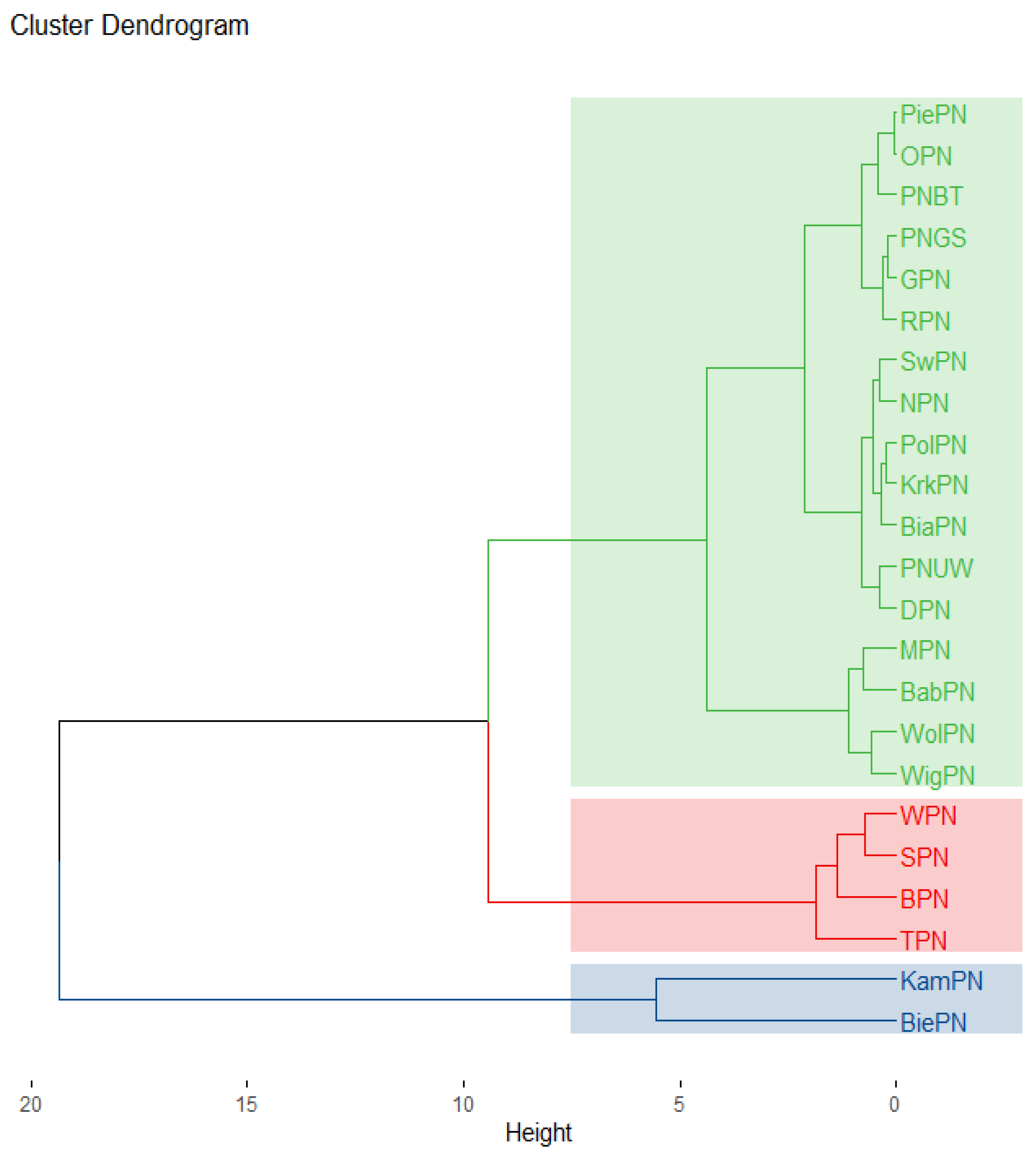
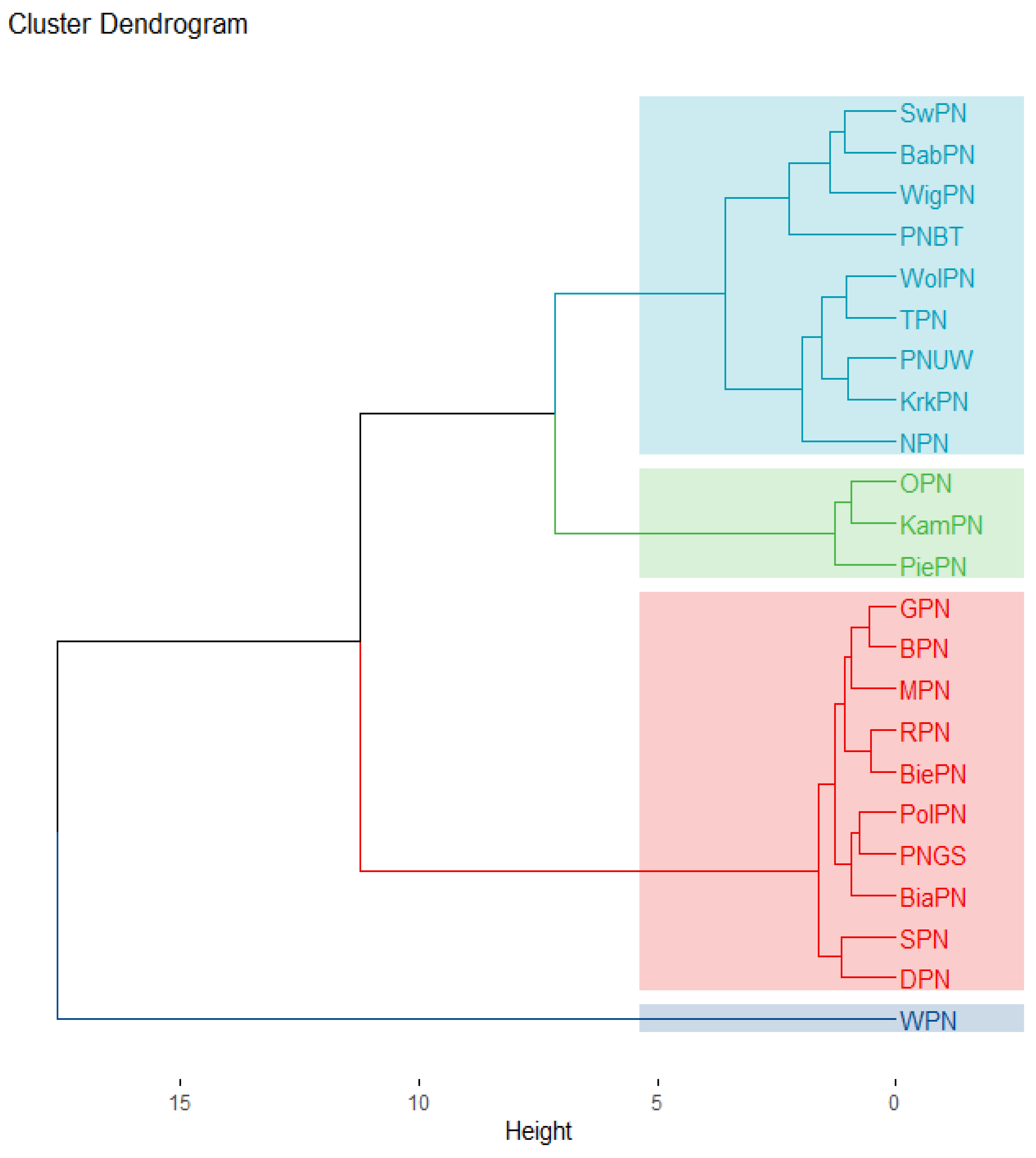
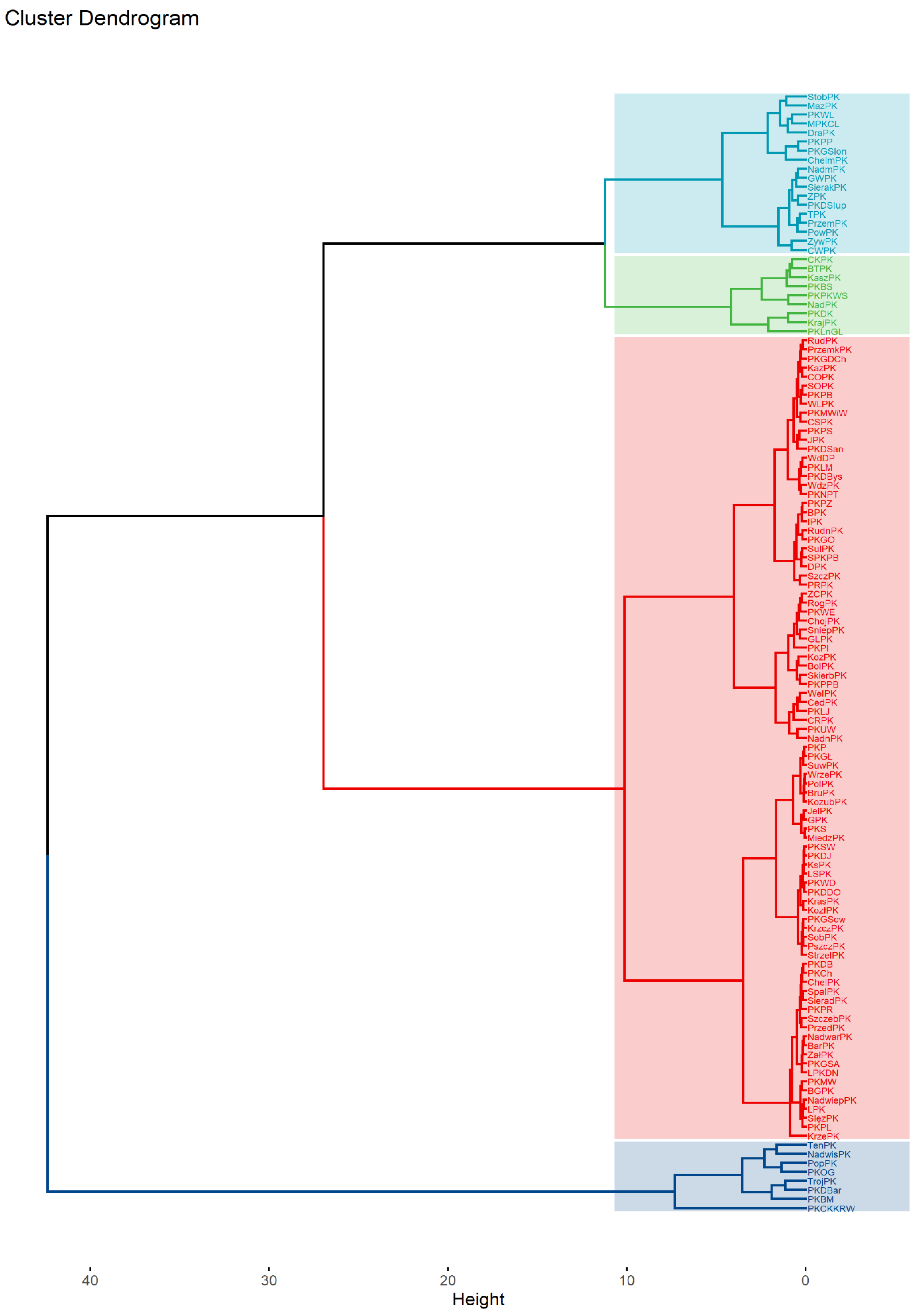
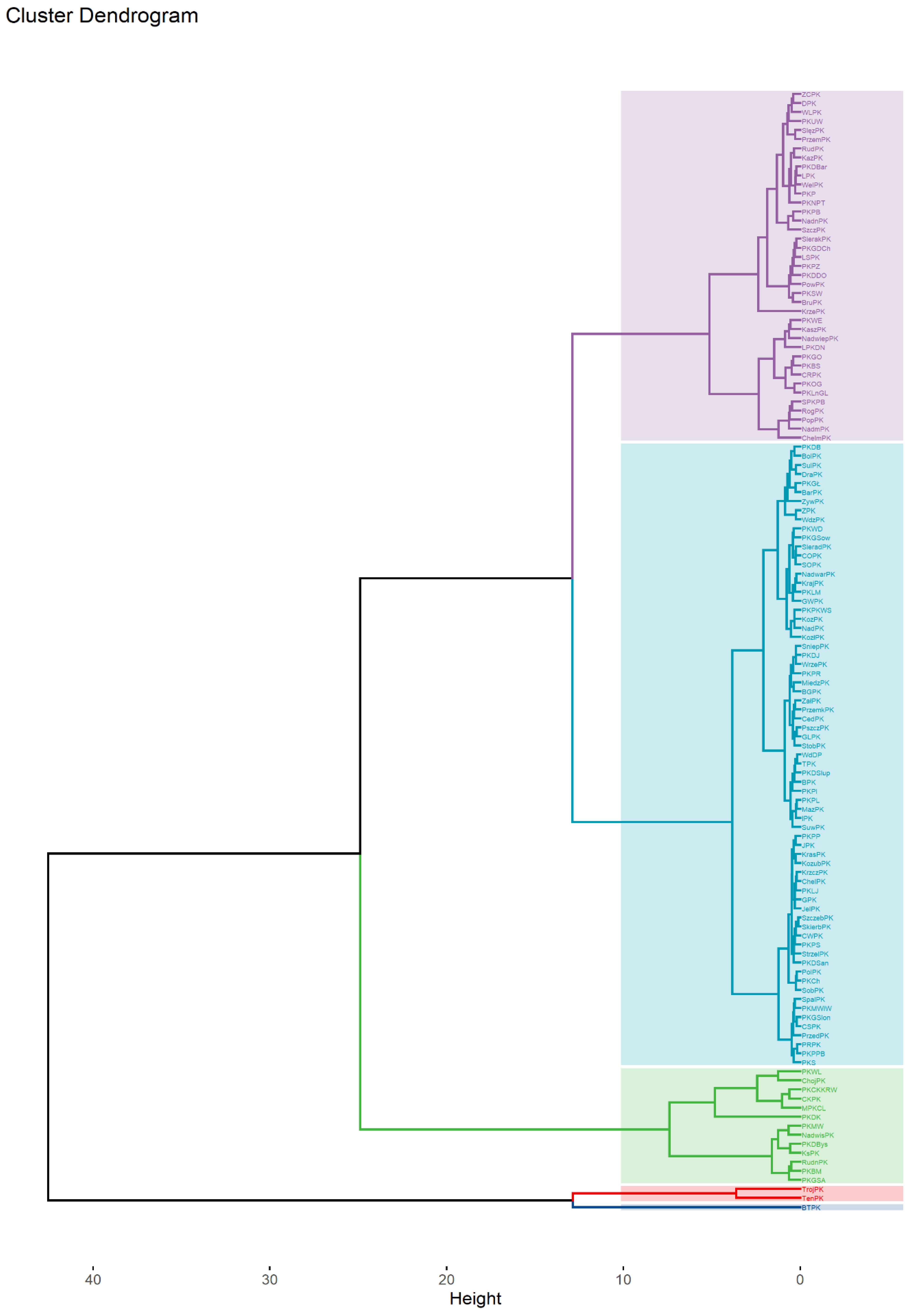

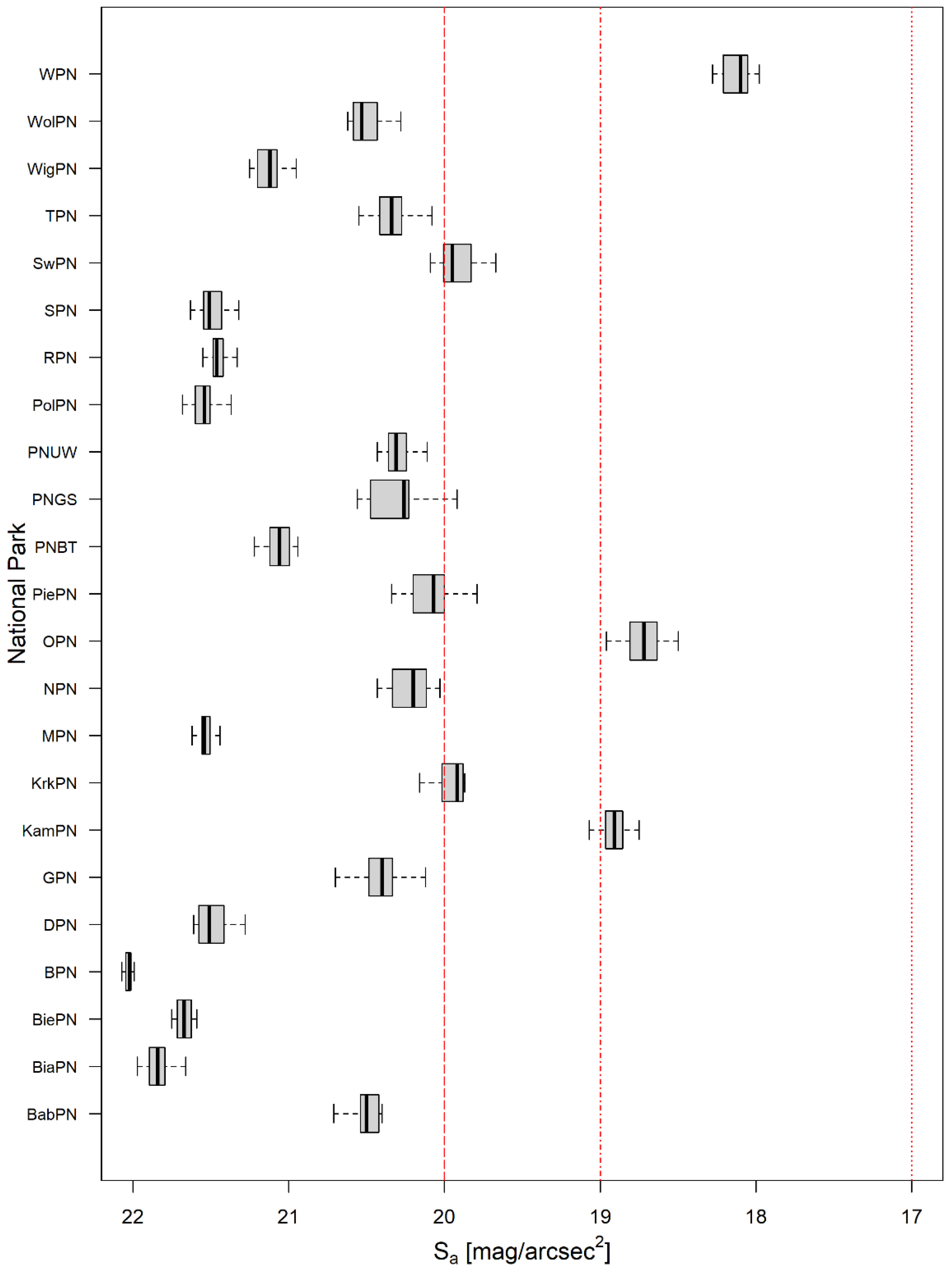
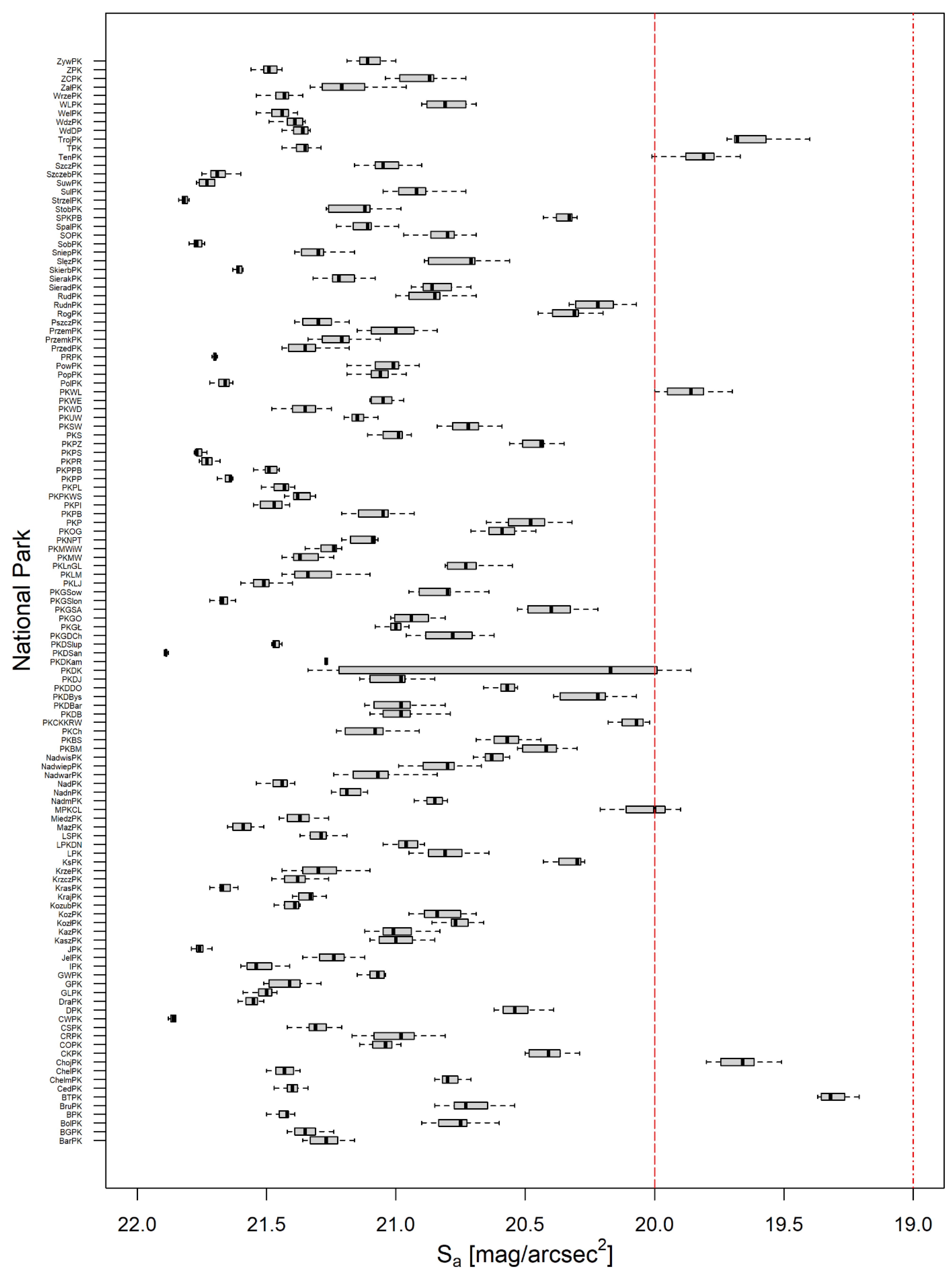
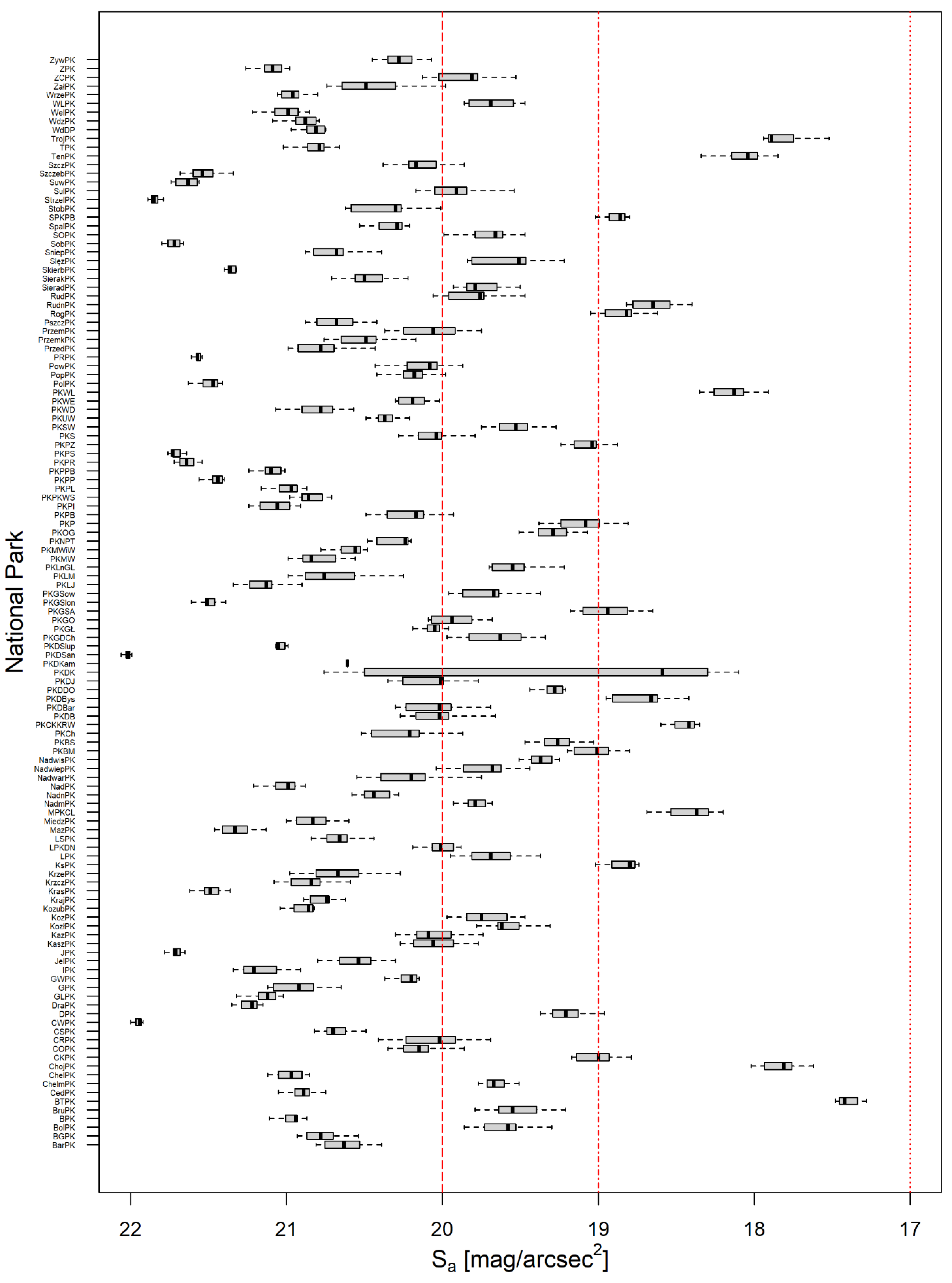
References
- Kyba, C.C.M.; Altintas, Y.O.; Walker, C.E.; Newhouse, M. Citizen scientists report global rapid reductions in the visibility of stars from 2011 to 2022. Science 2023, 379, 265–268. [Google Scholar] [CrossRef] [PubMed]
- Falchi, F.; Cinzano, P.; Duriscoe, D.; Kyba, C.C.M.; Elvidge, C.D.; Baugh, K.; Portnov, B.A.; Rybnikova, N.A.; Furgoni, R. The new world atlas of artificial night sky brightness. Sci. Adv. 2016, 2, e1600377. [Google Scholar] [CrossRef] [PubMed]
- What is Light Pollution? Available online: https://darksky.org/resources/what-is-light-pollution/ (accessed on 20 December 2024).
- Obayashi, Y.Y.; Shinobu, T.; Norio, K.; Keigo, S. Indoor light pollution and progression of carotid atherosclerosis: A longitudinal study of the HEIJO-KYO cohort. Environ. Int. 2019, 133, 105184. [Google Scholar] [CrossRef]
- Xu, Y.X.; Zhang, J.H.; Tao, F.B.; Sun, Y. Association between exposure to light at night (LAN) and sleep problems: A systematic review and meta-analysis of observational studies. Sci. Total Environ. 2023, 857, 159303. [Google Scholar] [CrossRef]
- Cinzano, P.; Falchi, F.; Elvidge, C.D. The first world atlas of the artificial night sky brightness. Mon. Not. R. Astron. Soc. 2001, 328, 689–707. [Google Scholar] [CrossRef]
- Longcore, T.; Rich, C. Ecological light pollution. Front. Ecol. Environ. 2004, 2, 191–198. [Google Scholar] [CrossRef]
- Wallner, S.; Kocifaj, M. Aerosol impact on light pollution in cities and their environment. J. Environ. Manag. 2023, 335, 117534. [Google Scholar] [CrossRef]
- Liu, M.; Li, W.; Zhang, B.; Hao, Q.; Guo, X.; Liu, Y. Research on the influence of weather conditions on urban night light environment. Sustain. Cities Soc. 2020, 54, 101980. [Google Scholar] [CrossRef]
- Gaston, K.J.; Ackermann, S.; Bennie, J.; Cox, D.T.C.; Phillips, B.B.; Sánchez de Miguel, A.; Sanders, D. Pervasiveness of biological impacts of artificial light at night. Integr. Comp. Biol. 2021, 61, 1098–1110. [Google Scholar] [CrossRef]
- Seymoure, B.M.; Buxton, R.; White, J.M.; Linares, C.R.; Fristrup, K.; Crooks, K.; Wittemyer, G.; Angeloni, L. Global artificial light masks biologically important light cycles of animals. Front. Ecol. Environ. 2025, 23, e2832. [Google Scholar] [CrossRef]
- Garrett, J.; Donald, P.; Gaston, K. Skyglow extends into the world’s key biodiversity areas. Anim. Conserv. 2019, 23, 153–159. [Google Scholar] [CrossRef]
- Evens, R.; Lathouwers, M.; Pradervand, J.; Jechow, A.; Kyba, C.C.M.; Shatwell, T.; Jacot, A.; Ulenaers, E.; Kempenaers, B.; Eens, M. Skyglow relieves a crepuscular bird from visual constraints on being active. Sci. Total Environ. 2023, 900, 165760. [Google Scholar] [CrossRef]
- Creemers, J.; Eens, M.; Ulenaers, E.; Lathouwers, M.; Evens, R. Skyglow facilitates prey detection in a crepuscular insectivore: Distant light sources create bright skies. Environ. Pollut. 2025, 369, 125821. [Google Scholar] [CrossRef]
- Kupprat, F.; Hölker, F.; Kloas, W. Can skyglow reduce nocturnal melatonin concentrations in Eurasian perch? Environ. Pollut. 2020, 262, 114324. [Google Scholar] [CrossRef]
- Hirt, M.R.; Evans, D.M.; Miller, C.R.; Ryser, R. Light pollution in complex ecological systems. Philos. Trans. R. Soc. B 2023, 378, 20220351. [Google Scholar] [CrossRef]
- Schreuder, D.A. Light trespass: Causes, remedies and actions. In Proceedings of the CIE/MBE Symposium “Lighting and Signalling for Transport”, Budapest, Hungary, 22–23 September 1986. [Google Scholar]
- Light Pollution—The Problem of Glare. Available online: https://www.rasc.ca/sites/default/files/LightPollution-TheProblemofGlare.pdf (accessed on 20 December 2024).
- Chepesiuk, R. Missing the dark: Health effects of light pollution. Environ. Health Perspect. 2009, 117, A20–A27. [Google Scholar] [CrossRef]
- Gaston, K.J.; Visser, M.E.; Hölker, F. The biological impacts of artificial light at night: The research challenge. Philos. Trans. R. Soc. B 2015, 370, 20140133. [Google Scholar] [CrossRef]
- Cao, M.; Xu, T.; Yin, D. Understanding light pollution: Recent advances on its health threats and regulations. J. Environ. Sci. 2022, 127, 589–602. [Google Scholar] [CrossRef]
- Bożejko, M.; Tarski, I.; Małodobra-Mazur, M. Outdoor artificial light at night and human health: A review of epidemiological studies. Environ. Res. 2023, 218, 115049. [Google Scholar] [CrossRef]
- Hölker, F.; Wolter, C.; Perkin, E.K.; Tockner, K. Light pollution as a biodiversity threat. Trends Ecol. Evol. 2010, 25, 681–682. [Google Scholar] [CrossRef]
- Falcón, J.; Torriglia, A.; Attia, D.; Viénot, F.; Gronfier, C.; Behar-Cohen, F.; Martinsons, C.; Hicks, D. Exposure to Artificial Light at Night and the Consequences for Flora, Fauna, and Ecosystems. Front. Neurosci. 2020, 14, 602796. [Google Scholar] [CrossRef] [PubMed]
- Owens, A.C.S.; Lewis, S.M. The impact of artificial light at night on nocturnal insects: A review and synthesis. Ecol. Evol. 2018, 8, 11337–11358. [Google Scholar] [CrossRef] [PubMed]
- Adams, C.A.; Fernández-Juricic, E.; Bayne, E.M.; St. Clair, C.C. Effects of artificial light on bird movement and distribution: A systematic map. Environ. Evid. 2021, 10, 37. [Google Scholar] [CrossRef]
- Stone, E.L.; Harris, S.; Jones, G. Impacts of artificial lighting on bats: A review of challenges and solutions. Mamm. Biol. 2015, 80, 213–219. [Google Scholar] [CrossRef]
- Vandersteen, J.; Kark, S.; Sorrell, K.; Levin, N. Quantifying the impact of light pollution on sea turtle nesting using ground-based imagery. Remote Sens. 2020, 12, 1785. [Google Scholar] [CrossRef]
- Bennie, J.; Davies, T.W.; Cruse, D.; Gaston, K.J. Ecological effects of artificial light at night on wild plants. J. Ecol. 2016, 104, 611–620. [Google Scholar] [CrossRef]
- Aubrecht, C.; Jaiteh, M.; Sherbinin, A. Global Assessment of Light Pollution Impact on Protected Areas. Available online: https://ciesin.climate.columbia.edu/sites/ciesin.climate.columbia.edu/files/content/light-pollution-Jan2010.cleaned.pdf (accessed on 13 May 2025).
- Gaston, K.J.; Duffy, J.P.; Bennie, J. Quantifying the erosion of natural darkness in the global protected area system. Conserv. Biol. 2015, 29, 1132–1141. [Google Scholar] [CrossRef]
- Sung, C.Y. Light pollution as an ecological edge effect: Landscape ecological analysis of light pollution in protected areas in Korea. J. Nat. Conserv. 2022, 66, 126148. [Google Scholar] [CrossRef]
- Ji, M.; Xu, Y.; Yan, Y.; Zhu, S. Evaluation of the light pollution in the nature reserves of China based on NPP/VIIRS nighttime light data. Int. J. Digit. Earth 2024, 17, 2347442. [Google Scholar] [CrossRef]
- Kurt, Z.; Aksaker, N.; Yerli, S.K.; Erdoğan, M.K. Investigating potential Dark Sky Parks in Balkans. Astrophys. Space Sci. 2024, 369, 84. [Google Scholar] [CrossRef]
- Kotarba, A.Z. (Ed.) Light Pollution in Poland. Report 2023; Centrum Badań Kosmicznych PAN: Warsaw, Poland, 2023. (In Polish) [Google Scholar]
- Dz.U. 2004 nr 92 poz. 880. Ustawa z Dnia 16 Kwietnia 2004 r. o Ochronie Przyrody. Available online: https://isap.sejm.gov.pl/isap.nsf/DocDetails.xsp?id=wdu20040920880 (accessed on 13 May 2025).
- Formy Ochrony Przyrody. Available online: https://www.gov.pl/web/gdos/formy-ochrony-przyrody (accessed on 21 December 2024).
- Kruczek, Z. Frekwencja w Atrakcjach Turystycznych w Roku 2020; Polska Organizacja Turystyczna: Warsaw, Poland, 2021. [Google Scholar]
- Rąkowski, G. Parki Narodowe w Polsce; Instytut Ochrony Środowiska: Warsaw, Poland, 2002. [Google Scholar]
- Rąkowski, G.; Smogorzewska, M.; Janczewska, A.; Wójcik, J.; Walczak, M.; Pisarski, Z. Parki Krajobrazowe w Polsce; Instytut Ochrony Środowiska: Warsaw, Poland, 2004. [Google Scholar]
- Palomo, I.; Martín-López, B.; Potschin, M.; Haines-Young, R.; Montes, C. National parks, buffer zones and surrounding lands: Mapping ecosystem service flows. Ecosyst. Serv. 2013, 4, 104–116. [Google Scholar] [CrossRef]
- Ściężor, T.; Czaplicka, A.; Czaplicka, Z. Light pollution in the Tatra National Park. Arch. Environ. Prot. 2024, 50, 22–30. [Google Scholar] [CrossRef]
- Iwanicki, G. The level of light pollution in Polish national parks. In Różnorodnie o Bioróżnorodności; Terlecka, M.K., Ed.; Wydawnictwo Armagraf: Krosno, Poland, 2014; pp. 31–40. (In Polish) [Google Scholar]
- Kosai, H.; Isobe, S. Organised observations of night-sky brightness in Japan during 1987–1989. Publ. Astron. Soc. Aust. 1991, 9, 180–183. [Google Scholar] [CrossRef]
- Cinzano, P.; Falchi, F.; Elvidge, C.D. Naked eye star visibility and limiting magnitude mapped from DMSP-OLS satellite data. Mon. Not. R. Astron. Soc. 2001, 323, 34–46. [Google Scholar] [CrossRef]
- Berry, R.L. Light pollution in Southern Ontario. J. R. Astron. Soc. Can. 1976, 70, 97–115. [Google Scholar]
- Bortle, J.E. Introducing the Bortle Dark-Sky Scale. Sky Telesc. 2001, 101, 126–129. [Google Scholar]
- Da Silva, A.; Kempenaers, B. Singing from North to South: Latitudinal variation in timing of dawn singing under natural and artificial light conditions. J. Anim. Ecol. 2017, 86, 1286–1297. [Google Scholar] [CrossRef]
- Bruni, A.; Mennill, D.J.; Foote, J.R. Dawn chorus start time variation in a temperate bird community: Relationships with seasonality, weather, and ambient light. J. Ornithol. 2014, 155, 877–890. [Google Scholar] [CrossRef]
- Da Silva, A.; Samplonius, J.M.; Schlicht, E.; Valcu, M.; Kempenaers, B. Artificial night lighting rather than traffic noise affects the daily timing of dawn and dusk singing in common European songbirds. Behav. Ecol. 2014, 25, 1037–1047. [Google Scholar] [CrossRef]
- Miller, M.W. Apparent effects of light pollution on singing behavior of American robins. Condor 2006, 108, 130–139. [Google Scholar] [CrossRef]
- Catto, C.M.; Racey, P.A.; Stephenson, P.J. Activity patterns of the serotine bat (Eptesicus serotinus) at a roost in southern England. J. Zool. 1995, 235, 635–644. [Google Scholar] [CrossRef]
- Voigt, C.C.; Dekker, J.; Fritze, M.; Gazaryan, S.; Hölker, F.; Jones, F.; Lewanzik, D.; Limpens, H.; Mathews, F.; Rydell, J.; et al. The impact of light pollution on bats varies according to foraging guild and habitat context. BioScience 2021, 71, 1103–1109. [Google Scholar] [CrossRef]
- Kawahara, A.Y.; Plotkin, D.; Hamilton, C.A.; Gough, H.; St Laurent, R.; Owens, H.L.; Homziak, N.T.; Barber, J.R. Diel behavior in moths and butterflies: A synthesis of data illuminates the evolution of temporal activity. Org. Divers. Evol. 2018, 18, 13–27. [Google Scholar] [CrossRef]
- Wong, L.M.K.; Didham, R.K. Global meta-analysis reveals overall higher nocturnal than diurnal activity in insect communities. Nat. Commun. 2024, 15, 3236. [Google Scholar] [CrossRef]
- Williams, C.B. The times of activity of certain nocturnal insects, chiefly Lepidoptera, as indicated by a light-trap. Trans. R. Entomol. Soc. Lond. 2009, 83, 523–556. [Google Scholar] [CrossRef]
- Owens, C.S.; Cochard, P.; Durrant, J.; Farnworth, B.; Perkin, E.K.; Seymoure, B. Light pollution is a driver of insect declines. Biol. Conserv. 2020, 241, 108259. [Google Scholar] [CrossRef]
- Cresswell, W.; Harris, S. The effects of weather conditions on the movements and activity of badgers (Meles meles) in a suburban environment. J. Zool. 1988, 216, 187–194. [Google Scholar] [CrossRef]
- Wise, S. Studying the ecological impacts of light pollution on wildlife: Amphibians as models. In Starlight: A Common Heritage; UNESCO—MaB: Paris, France, 2014; pp. 107–116. [Google Scholar]
- Grubisic, M. Waters under artificial lights: Does light pollution matter for aquatic primary producers? Bull. Limnol. Oceanogr. 2018, 27, 76–81. [Google Scholar] [CrossRef]
- Thomas, R.J.; Cuthill, I.C.; Goldsmith, A.R.; Cosgrove, D.F.; Lidgate, H.C.; Burdett Proctor, S.L. The trade-off between singing and mass gain in a daytime-singing bird, the European Robin. Behaviour 2003, 140, 387–404. [Google Scholar] [CrossRef]
- Cuthill, I.C.; MacDonald, W.A. Experimental manipulation of the dawn and dusk chorus in the blackbird Turdus merula. Behav. Ecol. Sociobiol. 1990, 26, 209–216. [Google Scholar] [CrossRef]
- Jechow, A.; Hölker, F. Snowglow—The amplification of skyglow by snow and clouds can exceed full moon illuminance in suburban areas. J. Imaging 2019, 5, 69. [Google Scholar] [CrossRef] [PubMed]
- Kyba, C.C.; Ruhtz, T.; Fischer, J.; Hölker, F. Cloud coverage acts as an amplifier for ecological light pollution in urban ecosystems. PLoS ONE 2011, 6, e17307. [Google Scholar] [CrossRef]
- Ribas, S.J.; Torra, J.; Figueras, F.; Paricio, S.; Canal-Domingo, R. Amplification (or not) of light pollution due to the presence of clouds. In Highlights on Spanish Astrophysics IX; Cambridge University Press: Cambridge, UK, 2017; pp. 754–759. [Google Scholar]
- Tomczyk, A.M.; Bednorz, E. (Eds.) Atlas klimatu Polski (1991–2020); Bogucki Wydawnictwo Naukowe: Poznań, Poland, 2022. (In Polish) [Google Scholar]
- Ściężor, T. Naturalne i Antropogeniczne Czynniki Łuny Świetlnej Nocnego Nieba; Wydawnictwo Politechniki Krakowskiej: Kraków, Poland, 2018. (In Polish) [Google Scholar]
- Garstang, R.H. Model for artificial night-sky illumination. Publ. Astron. Soc. Pac. 1986, 98, 364–375. [Google Scholar] [CrossRef]
- U.S. Standard Atmosphere, 1962; ICAO Standard Atmosphere to 20 Kilometers, Proposed ICAO Extension to 32 Kilometers, Tables and Data to 700 Kilometers. U.S. Government Printing Office: Washington, DC, USA, 1962.
- Román, M.O.; Wang, Z.; Sun, Q.; Kalb, V.; Miller, S.D.; Molthan, A.; Schultz, L.; Bell, J.; Stokes, E.C.; Pandey, B.; et al. NASA’s Black Marble nighttime lights product suite. Remote Sens. Environ. 2018, 210, 113–143. [Google Scholar] [CrossRef]
- Li, T.; Zhu, Z.; Wang, Z.; Román, M.O.; Kalb, V.L.; Zhao, Y. Continuous monitoring of nighttime light changes based on daily NASA’s Black Marble product suite. Remote Sens. Environ. 2022, 282, 113269. [Google Scholar] [CrossRef]
- Teikari, P. Light Pollution: Definition, Legislation, Measurement, Modeling and Environmental Effects; Universitat Politècnica de Catalunya: Barcelona, Spain, 2007. [Google Scholar]
- Guetté, A.; Godet, L.; Juigner, M.; Robin, M. Worldwide increase in artificial light at night around protected areas and within biodiversity hotspots. Biol. Conserv. 2018, 223, 97–103. [Google Scholar] [CrossRef]
- World List of Dark Sky Places. Available online: https://darksky.org/what-we-do/international-dark-sky-places/all-places/ (accessed on 12 May 2025).



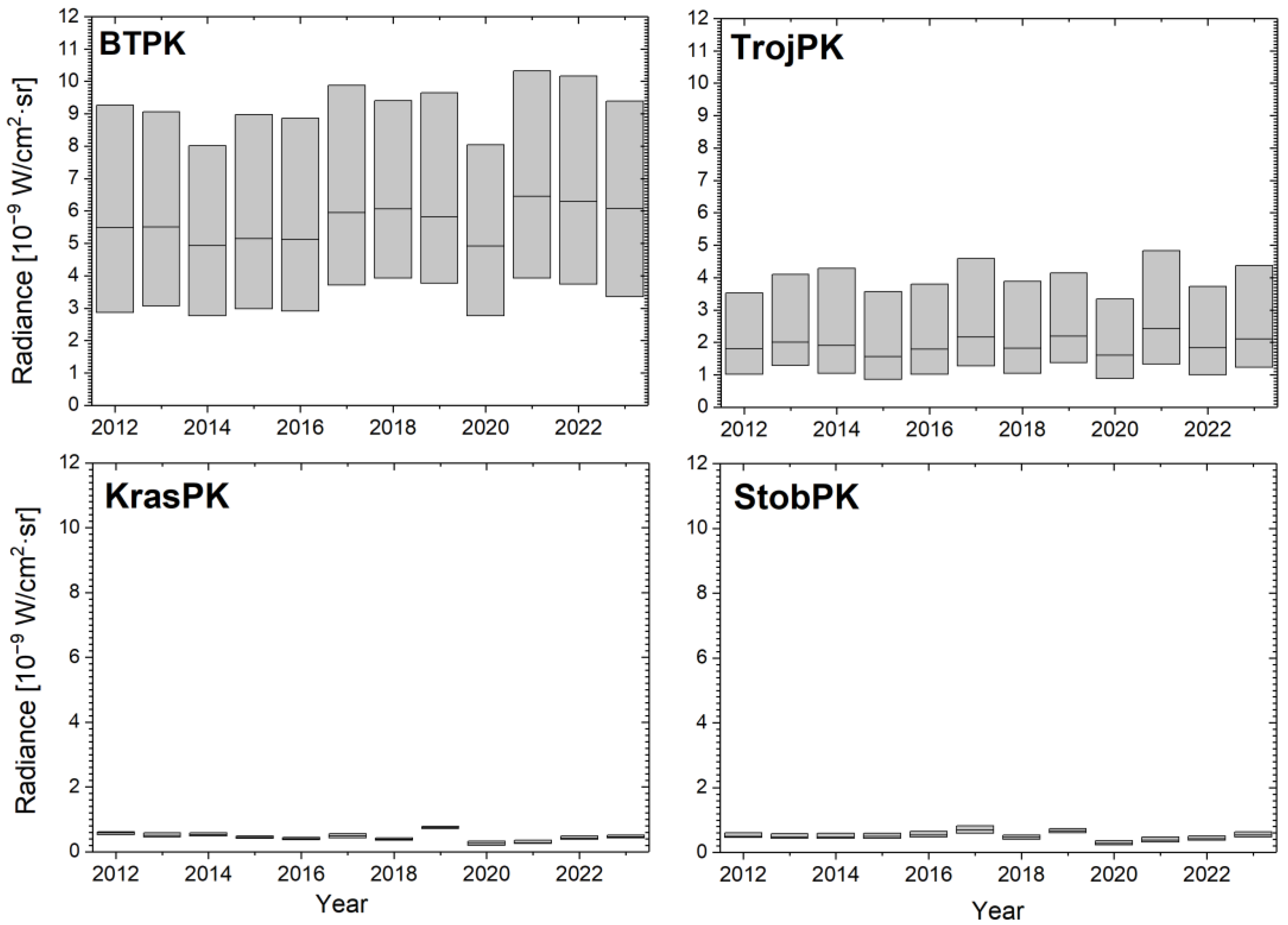
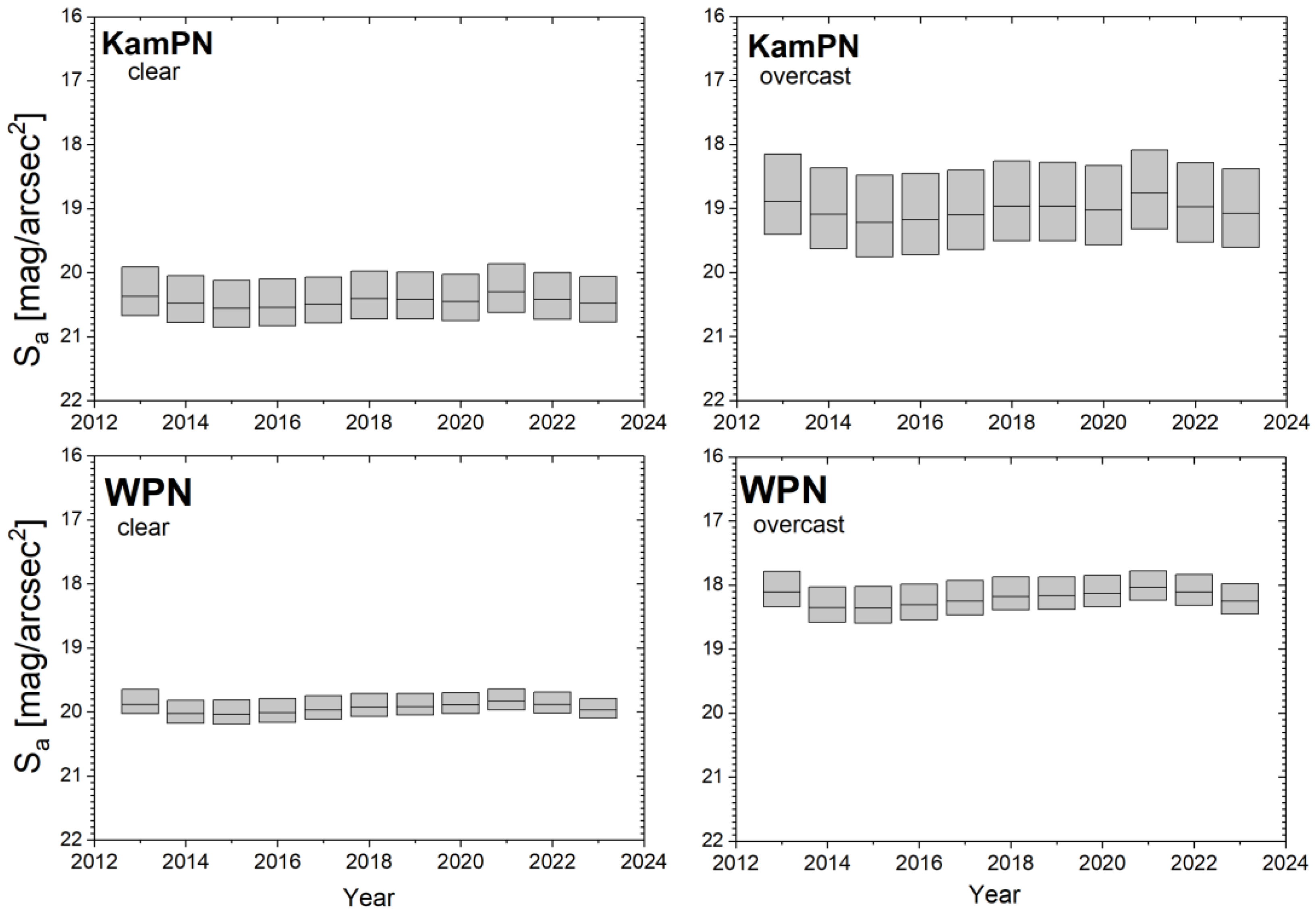

Disclaimer/Publisher’s Note: The statements, opinions and data contained in all publications are solely those of the individual author(s) and contributor(s) and not of MDPI and/or the editor(s). MDPI and/or the editor(s) disclaim responsibility for any injury to people or property resulting from any ideas, methods, instructions or products referred to in the content. |
© 2025 by the authors. Licensee MDPI, Basel, Switzerland. This article is an open access article distributed under the terms and conditions of the Creative Commons Attribution (CC BY) license (https://creativecommons.org/licenses/by/4.0/).
Share and Cite
Ściężor, T.; Iwanicki, G.; Kunz, M.; Kotarba, A.Z.; Skorb, K.; Tabaka, P. Ecological Light Pollution (ELP) Scale as a Measure of Light Pollution Impact on Protected Areas: Case Study of Poland. Sustainability 2025, 17, 4824. https://doi.org/10.3390/su17114824
Ściężor T, Iwanicki G, Kunz M, Kotarba AZ, Skorb K, Tabaka P. Ecological Light Pollution (ELP) Scale as a Measure of Light Pollution Impact on Protected Areas: Case Study of Poland. Sustainability. 2025; 17(11):4824. https://doi.org/10.3390/su17114824
Chicago/Turabian StyleŚciężor, Tomasz, Grzegorz Iwanicki, Mieczysław Kunz, Andrzej Z. Kotarba, Karolina Skorb, and Przemysław Tabaka. 2025. "Ecological Light Pollution (ELP) Scale as a Measure of Light Pollution Impact on Protected Areas: Case Study of Poland" Sustainability 17, no. 11: 4824. https://doi.org/10.3390/su17114824
APA StyleŚciężor, T., Iwanicki, G., Kunz, M., Kotarba, A. Z., Skorb, K., & Tabaka, P. (2025). Ecological Light Pollution (ELP) Scale as a Measure of Light Pollution Impact on Protected Areas: Case Study of Poland. Sustainability, 17(11), 4824. https://doi.org/10.3390/su17114824







